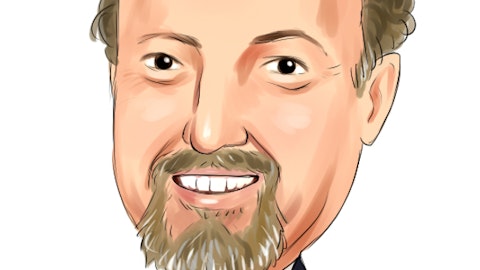Todd M. Schneider: Faiza, I’ll start, and then Mike can certainly chime in. As far as our results are quite good. We usually do grow in multiples of GDP. And — but we like where we are and where we’re heading. Regarding SAP, we’re very much in the early innings of SAP. That is the umbrella of our technology investment or the digitization of our business. And we went through all the implementation, which we’re still — there’s always work to be done there. But nevertheless, we’re seeing benefits from our technology investments. Our customers are seeing benefits from our technology investments. And we certainly love when we derive efficiencies from technology, but we get even more excited when our customers see benefits, giving us a competitive advantage in the marketplace.
So we’ve talked in the past about the certain advantages that we get with technology investments. My Cintas portal is one of the more obvious ones that the customers see an advantage. They get to be able to manage their account. They make request the majority of our requests are done outside of normal business hours. So our customers don’t always just want to be able to deal with our service provider in person or call our office during normal business hours. So they like to be able to do the flexibility to do business on their time and to get things off their list and move it on to ours. And that portal allows that flexibility for them and it’s showing up in customer satisfaction and customer loyalty. So yes, very much on the early innings of our technology deployment, I can certainly speak more to that, if you like.
J. Michael Hansen: Before you get into that, Todd, I just might remind — provide a reminder that, look, we love the market opportunity also for our business. And it’s — we look at it as a very, very big opportunity. So in other words, when we talk about we have a little bit over 1 million customers, there are 16 million customers or 16 million businesses in the U.S. and Canada, we’re just continuing to try to highlight that there is a great market opportunity, and Todd brought up the point that when the majority of our new business is expanding the served market or tapping into that large market potential, it means that we can grow in those multiples of GDP and employment growth for a long period of time. I think it’s important to keep that in mind as you think about the growth potential over the longer term, that market opportunity is great.
Faiza Alwy: Great, that’s really helpful. Maybe on the — I mean, I would love to hear more about the technology so I’ll leave it up to you in terms of how much more you’d like to share. But maybe specifically on the healthcare vertical, could you talk about what the growth trends have been like there, what they were like this particular quarter and sort of how they’ve been trending?
Todd M. Schneider: Certainly, the healthcare business is a great vertical for us. We have spent years organizing appropriately around that with our service providers, our sales partners, and we’ve organized around products and services that they find attractive. And so a good example of that is — let me back up, so our growth rates are very attractive there. They’re in excess of where we’re running in totality and they’re primarily due to what I just described, but also some specific products that we have launched. And we’ve spoken a little bit about the scrub business. When the scrub business historically was not a real attractive business for us and the reason being it was low-quality products, heavy low margin, and just they were kind of not treated as a disposable, but pretty close to a disposable product.
And we changed the game on that when we launched our garment dispensing service there, which controls the inventory levels for our customers. And here’s the big thing is it what it — because the technology controls it and only allows what the administrator of the hospital says each person can get, then what allows us to do is to provide a higher quality product but not be dealing with such low cost, low margin products. The customer is happier, we control the cost so much better because the inventory is controlled. So that’s a great example of one of the innovations that we brought to the healthcare industry. That certainly is a technology that people value, and it’s helping us grow that business really attractively. And we’re still very much in the early innings of that.
So hopefully, that gives you a little more color.
Operator: And our next question comes from George Tong from Goldman Sachs. Please go ahead George.
George Tong: Hi, thanks, good morning. I wanted to dive a little bit more into the selling environment. Can you discuss what you’re seeing with client sales cycles, budgets, and client headcount and what the implications are for the business?
Todd M. Schneider: Yes, thanks for the question George. I would say that the selling environment is very similar. It has not really changed much. Sales cycles, they’re not elongating the — what’s going on with our customers, they’re still fighting to bring people on to make sure that they’re providing the right levels of service. And in these types of environments, we help provide value to them. We provide a benefit to them running their business. And in many cases, we’re able to help customers save money from what they were doing. So I spoke earlier about when you walk into a customer and they’re not a programmer, well they still have products that — probably that they have procured on their own kind of a do-it-yourself and they’re struggling to keep up with that.
And in many cases, because of our scale and our ability to source products and the fact that we are already there, servicing them in many cases, we can provide great value for them and actually help lower their costs. So — and we’ve seen that throughout the years, and that’s a real benefit as we go through trying to provide value for our customers. So, generally speaking, George, I would say the selling environment is pretty similar — not a whole lot of change over the past six months or so.
George Tong: Got it. That’s helpful. And as a follow-up, you increased your full year guidance pretty much across the board. How much of that increase was driven by fiscal 3Q outperformance versus your internal expectations compared to a stronger fiscal 4Q outlook?
J. Michael Hansen: George, I don’t know if I can specifically separate the guidance raise. But clearly, we had a nice third quarter and the performance was strong from the organic growth to the gross margins to the operating margin. So a pretty solid quarter all the way through. And our guide for Q4 would suggest we expect more of the same. So the guide would suggest we expect another nice quarter. Hard to separate though for us exactly what the difference is because our internal expectations are a little bit different than our external, I’ll say, consensus and guide.
Operator: And our next question comes from Stephanie Moore from Jefferies. Please go ahead Stephanie.
Hans Hoffman: Hi, this is Hans Hoffman on for Stephanie. Thanks for taking my question. Just wanted to ask on margins, specifically the First Aid and Safety gross margin. Obviously, really strong and almost 52%. Is that just a function of kind of lower margin PPE sales rolling off and higher-margin cabinets business kind of becoming a larger part of the mix or is there anything else kind of to call out on the performance there and how should we be thinking about margins in that business on a go-forward basis?
Todd M. Schneider: Yes, Hans, it’s a good question and good morning. Certainly, we’re very happy with the trends that we’re seeing in the gross margin in the First Aid business, but we’re very happy in general with the First Aid business. It is — execution is at a very high level. Certainly, the mix of business is we’re benefiting from since PPE sales and safety sales tend to be lower margin, but there is strong demand for what we are providing. Health and Wellness is resonating in the marketplace. The mantra that we have in that business is what’s more important to a business than the health and safety of their people. So — and that is resonating. And so we’re getting good leverage from the growth and the mix, but strong execution and we really like how we’re operating in that business.
Hans Hoffman: Got it, thanks. And then just for my follow-up, I wanted to ask on the — all other segment. Clearly, really strong growth there in the quarter. And I know last quarter, you guys kind of talked about tougher comps, specifically in the Uniform Direct business in the second half of this year. I was just kind of curious what kind of drove the strong performance this quarter, as I think a lot of us kind of expected that to kind of show up in Q3?
Todd M. Schneider: Yes. It’s — certainly, the comps in Q4 are quite challenging and as Mike mentioned, we do expect that to moderate. The Uniform Direct Sale business is a little lumpier and sometimes, things come through based upon customer demand a little faster or what have you. But certainly, the comps in Q4 are tougher, and that’s part of our guide.
Operator: Our next question comes from Andrew Wittmann from R.W. Baird. Please go ahead Andrew.
Andrew Wittmann: Yes, great, thanks. And good morning everyone. I guess I was hoping, Mike, you could talk a little bit about some of the relevant inflationary factors that are driving so much, the stress in the overall economy. But specific to your business, I was wondering if you could talk about the — basically the COGS or merchandise costs, whether it’s for uniforms, mats or the ancillary services that you provide as well as address how labor is progressing in your business, have those things generally been — have you been able to get leverage on those items despite the challenges, in other words, are those down as a percentage of revenue in the quarter, can you just talk about the trend lines that you’re seeing in those if there’s any moderation or acceleration in them?
J. Michael Hansen: Sure. So I’ll start with material cost, Andrew. Let me start with we source or direct the sourcing of more than 90% of our volume and more than 90% of our items have more than one source. And that’s really important to keep in mind so that when our vendors may have inflationary pressures on them, the thing to remember is we have choices. And so sometimes that means we do have to take increases, but many times, it means we have — we can flex and we can negotiate and we can — again, we have choices. And so we don’t always have to accept every vendor price increase that comes our way when we direct to sourcing ourselves and when we have multiple sources, that’s really important. The other thing is, obviously, the amortization of this bucket of expenses allows us to see ahead, to anticipate what’s coming.
So as you can imagine, when a vendor does come to us and has a price increase, that — it takes a while to, first of all, build the inventory and then it goes to our distribution centers. And then for after a turn, it comes into our rental locations, and that’s where the amortization starts. And in month one, we have 1/18th of that inflation for garments, for example, 1/48th of that for entrance mats. And so you can kind of get a feel for it. It takes a long time for those inflationary pressures to come to us. That means we can do lots of planning. We can think about initiatives that we have going on, and we can accelerate some of those. We can think about process improvement and we can implement those, but we can also give in at least one annual price increase and maybe multiple price increases before that full inflation hits us.
So we can really get ahead of that kind of cost. So we have choices, and we can really see ahead of that. And that gives us a really nice opportunity to plan the business without a lot of disruption. The other thing I’ll say, Andrew, is we’ve got a lot of infrastructure. We’ve got a lot of facilities and trucks and things, rents. And those aren’t quite as disrupted by inflation or at least immediately. And so again, we can get with our great growth, we can get some really nice leverage on that part of our cost structure. And then when you think about labor that you touched on, Andrew, we certainly want to make sure that we are maintaining the absolute best partner engagement that we can, and that means we like to be at market or slightly above market rates, that’s important for us in terms of the labor rates.
But we’ve talked about — we’ve had a couple of things happen over the course of the last five or six years. One is, we had a lot of gene case synergies being realized over the course of the last six years, and that allowed us to be a little bit more aggressive on raising rates. So we were never caught flat footed in terms of when the labor challenges hit. That was — that’s been important to us, and it’s been — it has allowed us to kind of keep disruption down. But the other thing is, we’ve talked a lot about initiatives like Smart Truck. We talked a lot about the technology impacts in our facilities that allow us to be more efficient. So that means as we are growing, we don’t need to add as many resources within the plants or on the routes, and that allows us to leverage that labor environment even in this period of time where we’ve got raising labor rates.
Todd M. Schneider: Mike, if I can add, Andrew, certainly, in this type of inflationary environment, it’s challenging to grow gross margin. We’ve been quite successful in doing so. Getting good leverage on that revenue has been key for us. But managing our variable costs, it’s — that is just simply part of our culture, managing it very, very closely. So that’s been big. But to Mike’s point, in leveraging some of our digital transformation, Smart Truck has been very important to us. And then also the — managing our inventory at our used stock rooms has been really important. And we have good systems in place there that allows us to get better reuse, which is better for the customer because the speed at which we can provide products goes up because it’s right there available locally, don’t have to get it from a distribution center and ship it into us.
And it also, obviously, helps the amortization schedule when you can get better reuse of that current product that you’re already paying for. So, the leverage that we’re getting as a result of the systems and processes we put in place with technology have — are paying off.





